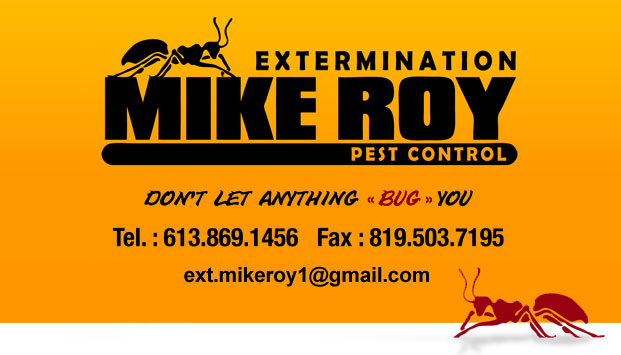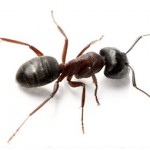Carpenter Ants
The carpenter ant is the insect that exterminators get the most calls for in Quebec.
And it’s no wonder, when you think that the population of a carpenter ant colony can reach 14,000! When carpenter ants get a foothold in a house, they go for the wooden supporting beams and joists. Unlike termites, they don’t actually eat the wood, they just destroy it. Carpenter ants cause structural damage to buildings by tunneling through wood to make room for their nests.
If you have a carpenter ant infestation, you must act quickly. The best thing to do is call a certified, professional exterminator to get rid of the ants using products approved by Health Canada and Environment Canada.
Identification
Carpenter ants are big, unwelcome insects measuring 6 to 25 mm in length. Two of the most commonly found in Canada are red carpenter ants, which have a dark brownish-black body with a reddish-brown mid-section, and black carpenter ants, which are a uniform brownish-black all over.
|
|
|
Carpenter ants are sometimes confused with termites, but it is easy to tell them apart: termites have a thick waist and straight antennae, while carpenter ants have a narrow waist and crooked antennae. Besides, termites are only found in some parts of Canada.
Chemical control methods have two major goals: eliminating existing nests and preventing recurrences. Chemical controls are most effective when used in conjunction with physical controls. For example, in the case of a well-established colony, any permanent or long-term solution would include locating and treating the actual nest site. In the case of a satellite colony, the parent colony would need to be located and destroyed.
For carpenter ant infestations, it is always better to call a certified exterminator, who has access to approved commercial products and who knows how to use them safely and effectively.
Signs of A CARPENTER ANT infestation
Carpenter ants have no business in the house. But before you panic, remember that one or two carpenter ants do not necessarily spell infestation. In the spring and summer, you could be getting visits from scout ants on a foraging mission. But if you have carpenter ants in the house in the winter months, then you might have unwanted guests. Here are some things to look for:
- A high concentration of ants in a particular area, like under the kitchen sink
- Ants that are active in winter, looking for food and water
- A swarm of winged reproductive ants trying to escape outdoors, usually in the spring
- Piles of sawdust-like borings expelled from ant galleries and slit-like openings in woodwork
- The dry rustling noise made by an active colony. It can be heard best at night, when ants are most active and the house is most quiet.
An ant colony is continuously active and most of it is hidden out of sight. If you find one, you should call Mike Roy Pest Control right away at 613-869-1456.
indirect ContrOL AND prEvention
Here are some things you can do to prevent carpenter ants from setting up camp in your home.
- Remove any source of dampness that could damage wood. Repair leaks in the roof and plumbing. Eliminate damp spots in the house by providing adequate ventilation.
- Get rid of any source of rotting wood close to the house and specifically, close to the foundation: plywood, old furniture, etc.
- Store firewood properly, off the ground and away from the building.Knock any insects out of firewood before you bring it in. Once the wood has warmed up, check for ants and eliminate them.
- Trim trees and shrubs so that the branches do not touch the house (ants can drop from a branch to explore new territory). Repair any damaged trees and shrubs and cut them back. Remove stumps.
- Inspect, clean and repair gutters regularly.
- Fill any cracks in the exterior siding and inspect the foundation. Seal doors and windows. Make sure all openings, including vents, are covered by a screen.
- Store any food that could attract ants.
Other types of ants
Ants may be black, brown, red or yellow. Adult ants range in size from as small as 1 millimetre (1/16 to 1/32 inch, e.g. little black ants and thief ants) to as large as 13 millimetres (1/2 inch) (e.g. carpenter ants).
The species of ants commonly found in Canada are not aggressive, although some can sting. Ants should be tolerated as much as possible as they cause little damage in the garden. They can even be considered beneficial because they eat other insects such as young silverfish and moths.
Species that are known to invade homes in Canada may include the carpenter ant, the little black ant, the odorous house ant, the thief ant and the pharaoh ant. Pavement ants can become a nuisance in lawns, gardens and pathways as well as indoors.
|
|
|
Here are some tips to help you prevent the spread of ants:
- Store ant-attractive foods in glass jars with rubber gaskets or in plastic containers with lids that snap tight.
- Keep kitchen countertops clean. Sweep or vacuum the floor frequently, especially around pet dishes
- Rinse containers before disposing of them in the garbage or in recycling bin
- Empty kitchen garbage containers frequently.
- Place composters at a reasonable distance from the house.
- Repair and seal as many visible cracks in the foundation and exterior walls of your house as possible.
- Indoors, caulk along baseboards, cracks and crevices to keep the ants from passing through your house–if necessary, use duct tape or petroleum jelly to temporarily seal cracks.
- Ants will not cross sticky barriers–try placing two-sided tape around the legs of plant stands.
- Place pet dishes in a shallow dish of water. Ants can’t swim, so they won’t be able to get at your pet’s food.
- Flood ant nests repeatedly with a garden hose to encourage the ants to move farther away from the house.
- Pour boiling water and detergent down the nest to temporarily reduce the population of a colony.
Numerous chemical treatments and products are used by professional exterminators to control ants:
- Applying a chemical directly on the nest may eliminate colonies.
- Foraging ants gather food and bring it back to the nest to feed ant colony members. A bait system therefore, must work slowly enough to allow the poison to be fed to all members of the nest.
- Chemical barrier treatments can be applied to baseboards or door and window-frames to prevent outdoor nesting species from foraging for food indoors.
- Spraying indoors where trails have been observed may cut off food and water sources for an indoor nest and encourage the colony to bud.
- Nests located indoors in wall voids can be treated with dusts that can be puffed into the area.
You don’t have to put up with an ant problem! Call the specialists at Mike Roy Pest Control – 613-869-1456.
Most of the information given here can be found in Health Canada’s site https://www.hc-sc.gc.ca/cps-spc/pubs/pest/_pnotes/ants-fourmis/index-eng.php







